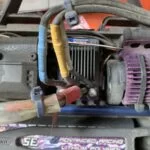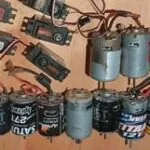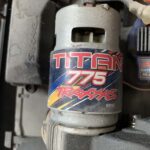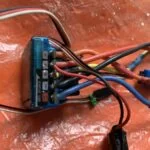Are heat sinks better than fans (Researched)

One of the most vital components of every RC vehicle is the motor. Why? It regulates your RC car’s performance. However, overheating or excessive heat can cause the motor to fail.
Even if you gear up your RC car with upgraded parts like bigger wheels, top-tier chassis and energy-efficient battery, your RC motor will continuously heat up, especially with a lack of ventilation. A motor fan or heat sink will do well to keep the motor cool, but do they actually work the same?
This article discusses the differences between heat sinks and fans to know which works better for your RC car.
Which is better, heatsink or fan?
Heatsinks and fans are both cooling agents for an RC which helps prolong the life of your RC car parts, especially when driving at the maximum RPM. However, both don’t play the same role in various RC motors.
Heat sinks are usually made from aluminum or copper materials. A heatsink has a large surface area that prevents the electronic components of your RC car from overheating. In essence, it helps maximize airflow to reduce power consumption and cool the electronic components of your RC car.
An RC fan is built using plastic or metal. Like the heatsink, they help reduce the motor temperature of your electronic parts, keep them cool and prevent overheating during long runs, especially when you change the batteries and continue driving. This, in turn, extends its life and prevents thermal overload on your RC vehicle. The difference, however, is in how they dissipate heat.
Understand that the more powerful your RC motor is, the hotter it will run. But, this is not advisable because a temperature higher than the recommended one can potentially damage your RC.
The amount of heat generated in the RC car\plane\helicopter\boat is often determined by how big the motor is and the rating of your commutator.
A heatsink will easily move heat around in the RC car and break up the thin layer of trapped heat on the surface of the RC motor as long as it gets air flow.
Fans push heat away from components. However, on its own, it won’t effectively dispel heat from electronic components like the heatsink.
To get more efficiency from your cooling system, you can easily combine the heat sink with the fan. This combined force makes your RC components sustainable over time.
Heat sink’s heat transfer coefficient
Heat transfer from the heat sink can be achieved through convection of the surrounding air,
The general definition of the heat transfer coefficient is:
h = q∆T
Where:
H is the heat transfer coefficient, W/(m2•K)
q is the thermal power per unit area, W/m2
ΔT is the difference in temperature between the solid surface and surrounding fluid area, K.
The heat sink’s heat transfer coefficient uses the SI unit in watts per square meter kelvin (W/(m2K)) in measurement.
Fan’s heat transfer coefficient
The fan uses convection heat transfer. Unlike the heat sink coefficient, we use the Nusselt number Nu to define the h (the ratio between the convection and conduction heat transfer), which is represented as:
NU = Convective heat transfer conductive heat transfer = (hᴄ ∗ L) /K
Where:
Nu: Nusselt number
hc: convective heat transfer coefficient
k: thermal conductivity, W/mK
L: characteristic length, m
The fan heat transfer coefficient is then defined as follows:
ℎc = Nu *KL
What is trapped heat?
Trapped heat is just as it sounds – it is heat produced from the motor\engine or from the electronics and has nowhere to go. When heat is trapped, it actually increases the amount of heat produced causing rapid heating.
In your RC vehicle, trapped heat acts more like boiling water in a cooking pot with the lid on.
As the engine work, the heat increases but has nowhere to go. This causes a rapid increase of the heat in the RC car, which can damage your RC components and this may cause damage to your motor, winding, or commuter.
Trapped heat is the reason all sort of electric components has ventilation holes, and it is the reason why electric motors and other rc components need air flow around them.
How does a heat sink dispatch heat?
Heat sinks dispatch heat by increasing the device surface area and redirecting heat flow away from any hot device in the RC vehicle, especially the RC motor. However, they can only achieve this when they have a temperature higher than the surroundings to transfer heat easily.
Add to that, they are most efficient when have air flow around them that help push heat away from it.
What are the pros and cons of heat sinks and fans?
When it involves their size, heatsinks are lightweight and can fit on your RC engine’s bottom without affecting weight distribution. They are also efficient in heat dissipation while ensuring the longevity of your electronics.
Add the fact that they are pretty durable since they are made from high-quality materials. Hence, you won’t have to worry about replacing them often. They aren’t as noisy as fans making them a superior coolant for your RC car.
The only con of a heat sink is that they are expensive and won’t usually fit every engine since you have to ensure their temperature is higher than that of the motor.
On the other hand, a fan can move lots of air and effectively dispels heat.
However, they are usually noisy, can fail easily, and require regular maintenance, unlike heatsinks. You also need to be careful of the heat sink size you choose because if the weight of your RC car is significantly increased, the extra weight will cause the motor to work harder and create extra heat.
The best heatsink with a fan
You can choose to use your fan or heat sink alone, but combining both will be more effective than when you choose one.
If you’re considering this option, the best heatsinks with a fan you’d want to go for is the Powerhobby 1/5 Twin Motor Cooling Heat Sink Fan.
This heatsink fan is extremely large, comes with a high rotation speed and great airflow for cooling efficiency. Plus, the fan house is made with heat-resistant material, can fit a 1100Kv / 800Kv brushed motor and are easy to install.
3 heatsinks to consider
There are so many options in the market when it comes to choosing a heatsink for your RC car. But, three of the best to consider include:
- ShareGoo Alloy Heat Sink Heatsink
Features
- It fits a 540 And 3650 Size Motor,
- Made with high-quality aluminum
- Keep RC car temperatures in check and your motor running efficiently
- JFtech Aluminium Alloy RC Electric Motor Heat Sink
Features
- Fit For 540, 550 And 3650 Size Motor
- Made from Aluminium Alloy
- Weights 21.5g
- Easy and convenient to use
- FriHobby Aluminum Motor Heat Sink
Features
- Compatible With 1/10 Scale Traxxas E-Revo Summit Monster Truck, And Other 1/10 1/8 Models That Has 40-43Mm Diameter Motor
- The RC Motor Radiator Fit 40Mm, 41Mm, 42Mm, electric engine motors
- Made of quality aluminum,
Conclusion
The heat sinks and fan works to distribute the heat of your motor and potentially cool it down. However, fans won’t work as effectively when you use them on their own. Regardless, since overheating can cause the RC motor to fail, heatsinks and fans prevent your motor from being burnt out.
Sources
https://en.wikipedia.org/wiki/Heat_sink
https://lisafea.com/pdf/Convection_heat_transfer_coefficient.pdf
https://en.wikipedia.org/wiki/Heat_transfer_coefficient
https://climate.nasa.gov/faq/19/what-is-the-greenhouse-effect/
https://altasimtechnologies.com/estimating-heat-transfer-coefficients/





